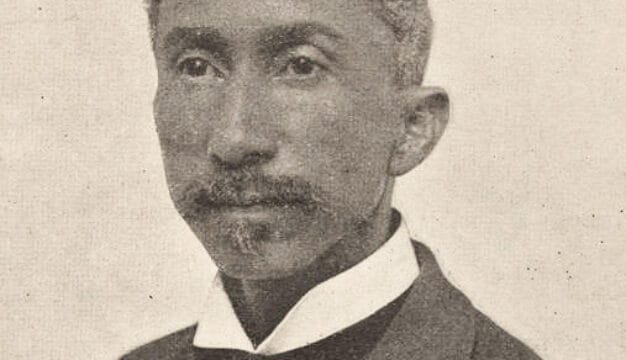The Montgomery Advertiser
 Wayne Greenhaw in Montgomery
Since it began publication in 1829, the Montgomery Advertiser has chronicled Alabama‘s most significant events, including economic booms and busts, wars, the civil rights movement, and natural disasters in Montgomery, Montgomery County, the state, and the wider world. The Advertiser and the jointly owned Alabama Journal won three Pulitzer Prizes in the twentieth century. Many noted journalists, including Gould Beech, Kathryn Tucker Windham, Bob Ingram, Ray Jenkins, and Wayne Greenhaw have contributed. The Advertiser remains one of the most widely read daily newspapers in the state.
Wayne Greenhaw in Montgomery
Since it began publication in 1829, the Montgomery Advertiser has chronicled Alabama‘s most significant events, including economic booms and busts, wars, the civil rights movement, and natural disasters in Montgomery, Montgomery County, the state, and the wider world. The Advertiser and the jointly owned Alabama Journal won three Pulitzer Prizes in the twentieth century. Many noted journalists, including Gould Beech, Kathryn Tucker Windham, Bob Ingram, Ray Jenkins, and Wayne Greenhaw have contributed. The Advertiser remains one of the most widely read daily newspapers in the state.
Early Statehood
The roots of the newspaper that would become the Montgomery Advertiser lie in the founding of the Montgomery Republican and the Planters Gazette. The Montgomery Republican began publication in 1821, with Bostonian Jonathan Battelle as editor and New Yorker Edward W. Thompson as printer. The following year, Battelle sold the paper to Thompson and physician Moses Andrew. In 1824, Andrew and Thompson sold the Republican to Henry Goldthwaite, who in turn sold it to future Georgia governor George Washington Bonaparte Towns in 1825. Towns changed the name to the Alabama Journal and shifted the editorial focus to back the Whig Party. In 1829, Thompson started the Planters Gazette, which backed the Democratic Party. William Cook bought the Gazette in 1830 and in the same year was joined as co-owner by James E. Belser. In September 1832, Hooper Caffey replaced Cook as co-owner. Hugh M. McGuire replaced Caffey on April 1, 1833, and he and Belser changed the name to the Montgomery Advertiser and Planters Gazette. By 1836, the name had become simply the Montgomery Advertiser. The paper went through a series of changes in co-owners during the late 1830s and into the 1840s, although Belser remained an owner until 1847.
During much of this era, the Journal and the Advertiser were united in Montgomery boosterism but differed over politics. The Democratic Advertiser applauded Pres. John Tyler’s 1841 veto of a bill to create a national bank, whereas the Whig Journal favored the bill. In the gubernatorial election that year, the Advertiser supported the successful Democratic candidate, Col. Benjamin Fitzpatrick, and the Journal backed Whig James W. McClung.
The Secession Crisis and War
In 1846, Montgomery became the state capital, with the support of both papers, and the following year publisher John McCormick moved his paper, the Flag of the Union, from Tuscaloosa, Tuscaloosa County, to the new capital. He merged his paper with the Montgomery Advertiser, buying Belser’s share, and with Walsh published the paper under the name Flag and Advertiser from January 1, 1847, to December 7, 1848. In 1848, the Alabama Journal, which would oppose secession in its editorial pages, and the pro-slavery Flag and Advertiser jousted over the expansion of slavery into U.S. territories as well as local and presidential politics. In the presidential election of 1848, the Journal backed the winning ticket, Whigs Zachary Taylor and Millard Fillmore, and the paper continued to push a moderate stance on slavery. McCormick sold the Flag and Advertiser to Patrick Henry Brittan, former publisher of the Chambers Tribune in 1849. Sources differ over ownership during this period: one source describes Brittan and Thomas DeWolfe as co-owners from January 6, 1849, to April 1853, but another source states that DeWolfe started the State Gazette in 1849; on October 31, 1849, the two papers were merged into the Montgomery Advertiser and State Gazette. The paper promoted secession as the national debate over slavery began to heat up. By 1857, the Advertiser greatly reduced its publication schedule, and by 1858 the Journal had gone out of business.
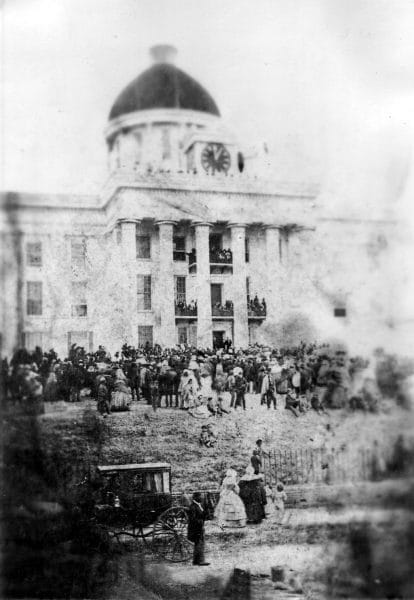 Inauguration of Jefferson Davis
After Abraham Lincoln was elected president, the Advertiser, with George H. Shorter as editor, called for secession. In 1861, Samuel G. Reid became editor of the Advertiser and continued to push for disunion. After secession, the Advertiser was named the official printer for the Confederate Congress, and Reid served on the presidential reception committee for Jefferson Davis, who was inaugurated as president of the Confederate States of America on the Capitol steps in Montgomery on February 18, 1861. The Advertiser’s Washington correspondent reported on Abraham Lincoln’s inauguration as well. Shorter joined the Confederate Army but remained half-owner until 1864. The Civil War interfered with news coverage by telegram, and as the war continued, the physical size of the newspaper diminished. The Advertiser sponsored a raffle to raise money for a gunboat and covered fund-raisers for the Confederate Army.
Inauguration of Jefferson Davis
After Abraham Lincoln was elected president, the Advertiser, with George H. Shorter as editor, called for secession. In 1861, Samuel G. Reid became editor of the Advertiser and continued to push for disunion. After secession, the Advertiser was named the official printer for the Confederate Congress, and Reid served on the presidential reception committee for Jefferson Davis, who was inaugurated as president of the Confederate States of America on the Capitol steps in Montgomery on February 18, 1861. The Advertiser’s Washington correspondent reported on Abraham Lincoln’s inauguration as well. Shorter joined the Confederate Army but remained half-owner until 1864. The Civil War interfered with news coverage by telegram, and as the war continued, the physical size of the newspaper diminished. The Advertiser sponsored a raffle to raise money for a gunboat and covered fund-raisers for the Confederate Army.
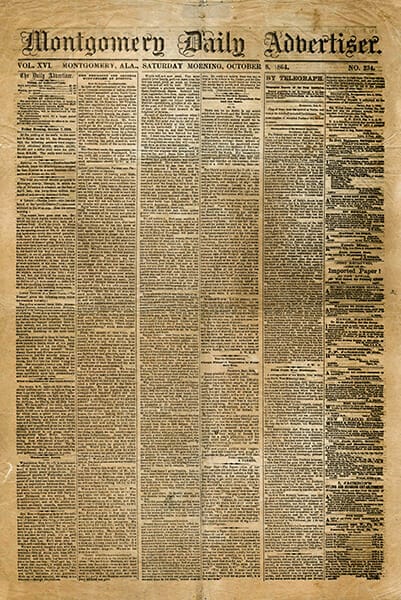 Montgomery Advertiser, 1864
Barbour County native William Wallace Screws, who had settled in Montgomery just prior to the Civil War to practice law, was one of the first Alabamians to volunteer for service. During the war, he wrote letters to the Advertiser about his service and other aspects of the conflict. Reid gave extensive coverage to Confederate general Nathan Bedford Forrest’s April 1864 conquest of Fort Pillow, Tennessee, where hundreds of black soldiers were killed. The federal government called it a massacre of surrendered troops. Forrest said the soldiers had been killed after they refused to surrender. Screws joined the Advertiser as associate editor in July 1865 and became part owner and editor in November.
Montgomery Advertiser, 1864
Barbour County native William Wallace Screws, who had settled in Montgomery just prior to the Civil War to practice law, was one of the first Alabamians to volunteer for service. During the war, he wrote letters to the Advertiser about his service and other aspects of the conflict. Reid gave extensive coverage to Confederate general Nathan Bedford Forrest’s April 1864 conquest of Fort Pillow, Tennessee, where hundreds of black soldiers were killed. The federal government called it a massacre of surrendered troops. Forrest said the soldiers had been killed after they refused to surrender. Screws joined the Advertiser as associate editor in July 1865 and became part owner and editor in November.
On April 18, 1865, the Advertiser reported that Montgomery officials had surrendered the city to federal forces a week earlier. U.S. Army general A. D. Smith (sometimes A. J. Smith) officially suspended publication of the paper, but before the U.S. forces arrived, Reid sent his presses and newsprint paper to Columbus, Georgia, to continue publication; however, a fire destroyed them. Many Advertiser files were burned in a Montgomery street by federal soldiers after Reid’s departure. The paper resumed publication in Columbus on July 20, 1865, with permission of the provisional governor and military officials. After the war, the newspaper returned to Montgomery, and Reid sold Screws a half interest in the newspaper and named him editor.
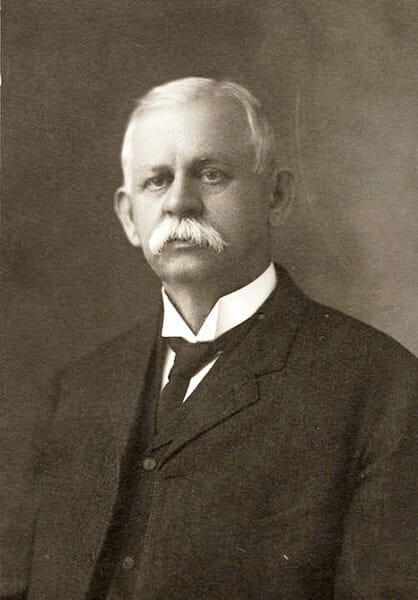 William W. Screws
During Reconstruction, the Advertiser continued to promote southern rights and the Democratic Party, although he was sympathetic to the plight of freedpeople. Screws served as a trustee for the black reformatory at Mount Meigs and called for assistance to sick and indigent freedpeople. In 1871, the Advertiser absorbed the Daily Montgomery Mail, founded in 1854 by J. A. Holifield and humorist and author Johnson Jones Hooper. Throughout Reconstruction, Reid and Screws concentrated on local events and shied away from national political commentary. In the lead-up to a vote on a new state constitution on February 4-5, 1868, editor Robert Tyler called for its defeat. Reid retired in 1868, and sold his part of the paper.
William W. Screws
During Reconstruction, the Advertiser continued to promote southern rights and the Democratic Party, although he was sympathetic to the plight of freedpeople. Screws served as a trustee for the black reformatory at Mount Meigs and called for assistance to sick and indigent freedpeople. In 1871, the Advertiser absorbed the Daily Montgomery Mail, founded in 1854 by J. A. Holifield and humorist and author Johnson Jones Hooper. Throughout Reconstruction, Reid and Screws concentrated on local events and shied away from national political commentary. In the lead-up to a vote on a new state constitution on February 4-5, 1868, editor Robert Tyler called for its defeat. Reid retired in 1868, and sold his part of the paper.
During the late 1880s, the rival Evening Journal began publication under the ownership of Tennessean Horace Hood, who claimed his afternoon paper was fact-based and unbiased and was not connected to a political party. In March 1891, he changed its name to the Montgomery Journal. Frank Harvey Miller bought half-interest in 1903.
The Progressive Era
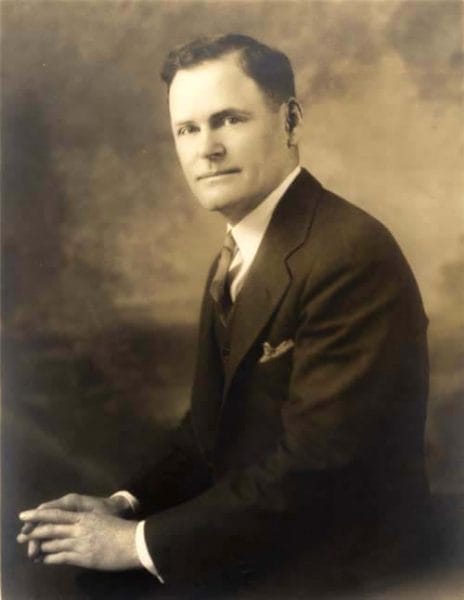 Grover Hall
In 1911, Alabamian Grover Cleveland Hall was hired as associate editor of Advertiser. After Screws died in 1913, William T. Sheehan became the editor. In July 1926, Victor Hanson became the new publisher, with editor Sheehan remaining co-owner. Hanson, also publisher of the Birmingham News, named Hall editor. In 1927, Hall wrote a series of editorials condemning a rash of public floggings of African Americans across the state by the Ku Klux Klan and earned a Pulitzer Prize for the series the following year. In December 1927, Hanson was succeeded by Franklin P. Glass. Hall and Glass backed Democrat Alfred E. Smith in the contentious 1928 presidential election, which complicated allegiances in the South. The Alabama Journal backed Republican candidate Herbert Hoover, expressing prejudice against Smith’s Catholicism and anti-temperance platform. Hall and Glass urged repeal of Prohibition, whereas the Alabama Journal pushed for its continuation. Hall was the first Alabama editor to endorse Franklin Delano Roosevelt for president in 1932.
Grover Hall
In 1911, Alabamian Grover Cleveland Hall was hired as associate editor of Advertiser. After Screws died in 1913, William T. Sheehan became the editor. In July 1926, Victor Hanson became the new publisher, with editor Sheehan remaining co-owner. Hanson, also publisher of the Birmingham News, named Hall editor. In 1927, Hall wrote a series of editorials condemning a rash of public floggings of African Americans across the state by the Ku Klux Klan and earned a Pulitzer Prize for the series the following year. In December 1927, Hanson was succeeded by Franklin P. Glass. Hall and Glass backed Democrat Alfred E. Smith in the contentious 1928 presidential election, which complicated allegiances in the South. The Alabama Journal backed Republican candidate Herbert Hoover, expressing prejudice against Smith’s Catholicism and anti-temperance platform. Hall and Glass urged repeal of Prohibition, whereas the Alabama Journal pushed for its continuation. Hall was the first Alabama editor to endorse Franklin Delano Roosevelt for president in 1932.
In May 1935, Richard F. Hudson purchased the Advertiser and became publisher. Hall stayed on as editor. Hudson bought the Alabama Journal in 1940, ending a longtime rivalry, and published the Advertiser in the morning and the Journal in the evening. Also, in 1940, noted storyteller and folklorist Kathryn Tucker Windham joined the staff of the Journal, covering the police beat. Hall died in January 1941 during service in World War II and was replaced by Advertiser associate editor Gould Beech. Beech also had written editorials critical of lynching, the tenant farmer system, and disfranchisement of blacks and poor whites, and under his guidance, the editorial page of the Advertiser continued to protest injustice and racism. Prior to World War II, associate editor R. F. Hudson Jr., the owner’s son, wrote a number of pieces criticizing Germany’s Hitler and his Nazi Party. In 1947, Hall’s son, Grover C. Hall Jr. became associate editor. During the Montgomery Bus Boycott, which began in 1955, the Advertiser provided invaluable local coverage of the movement’s daily activities and events.
In 1963, Hudson sold both papers to Texas newspaper entrepreneur Carmage Walls, head of Southern Newspapers Inc. Walls retained some of the administrative staff and started a profit-sharing retirement plan, relieved Grover C. Hall Jr. of administrative duties, and eliminated the special edition of the Advertiser for African Americans that had existed since 1935.
 Lurleen Wallace and Turkey
Much of the Advertiser’s coverage for a quarter-century focused on the dominant political figure of the era, Gov. George C. Wallace. The Advertiser’s Ramona Martin wrote a serialized biography of Wallace, and Bob Ingram reported from Wallace’s campaign trail of nearly 2,000 miles. The Advertiser opposed the candidacy of Lurleen Burns Wallace in 1966, who was entered into the race because Wallace was unable to succeed himself for a second term. In the bitterly contested Democratic primary runoff in 1970 between Wallace and Albert Brewer, the Advertiser endorsed Brewer, and the newspaper again endorsed Wallace’s opponent in the 1982 gubernatorial race.
Lurleen Wallace and Turkey
Much of the Advertiser’s coverage for a quarter-century focused on the dominant political figure of the era, Gov. George C. Wallace. The Advertiser’s Ramona Martin wrote a serialized biography of Wallace, and Bob Ingram reported from Wallace’s campaign trail of nearly 2,000 miles. The Advertiser opposed the candidacy of Lurleen Burns Wallace in 1966, who was entered into the race because Wallace was unable to succeed himself for a second term. In the bitterly contested Democratic primary runoff in 1970 between Wallace and Albert Brewer, the Advertiser endorsed Brewer, and the newspaper again endorsed Wallace’s opponent in the 1982 gubernatorial race.
Harold E. Martin became associate publisher in 1963. Walls sold the papers to Multimedia Inc., of Greenville, South Carolina, in 1969, and Martin became editor and publisher. In 1970, he published a series of articles exposing the use of Alabama prisoners for drug experiments and blood plasma. The series won a Pulitzer Prize that year for specialized local reporting.
In 1986, the Alabama Journal was among the few newspapers in the state to endorse Republican Guy Hunt for governor; he would win the election as a result of in-fighting among Democratic candidates. Under publisher Richard H. Amberg Jr., in 1988 the Alabama Journal won another Pulitzer for its five-part series titled “A Death in the Family, Alabama’s Infant Mortality Crisis.” That investigation of the state’s unusually high infant-mortality rate prompted the passage of legislation aimed at correcting the situation.
Changing Fortunes
On April 19, 1993, Multimedia ceased publication of the afternoon Journal and absorbed its staff and features into the morning Advertiser. The surviving morning newspaper produced an afternoon extra on April 22, 1993, when Hunt was removed from office for misuse of campaign funds. Subsequent extras were produced on April 5, 1995, one day after Hurricane Opal struck, and after the terrorist attacks of September 11, 2001. The Advertiser also commemorated the 50th anniversary of the Montgomery Bus Boycott with a special section called “Voices of the Boycott.”
In December 1995, Multimedia sold its holdings to Gannett Company Inc., one of the nation’s largest media companies and best known as the parent company of USA Today. On September 30, 2002, the Advertiser moved to a 16-acre site on the riverfront near Union Station. In 1999, the Advertiser broke with popular opinion and endorsed Democratic attorney Bobby Bright for Montgomery’s mayor over longtime incumbent Republican Emory Folmar. Bright would go on to win the race and then on to a term in the U.S. Congress. The Advertiser endorsed Barack Obama in both the 2008 and 2012 presidential races, garnering criticism from the state’s largely Republican voter base.
In recent years, the Advertiser has covered such controversial topics as Alabama Supreme Court Chief Justice Roy Moore’s unsuccessful battle to keep his Ten Commandments monument in the state judicial building in 2003; former Gov. Don Siegelman‘s 2006 conviction on bribery charges; and federal trials in 2011 and 2012 on the state’s casino businesses and their influence on legislative actions. The Advertiser also made news when it hired its first African American executive editor in 2004, naming USA Today senior editor Wanda Lloyd to the post; she retired in 2013. In 2010, Gannett veteran Samuel P. Martin became the newspaper’s first African American publisher and president. He was replaced in 2013 by Robert Granfield Jr., who served until 2016. Michael Galvin then helmed the newspaper until 2019.
Additional Resources
Ellison, Rhoda Coleman. History and Bibliography of Alabama Newspapers in the Nineteenth Century. Tuscaloosa: University of Alabama Press, 1954.
Flynt, Wayne. Montgomery: An Illustrated History. Woodland Hills, Calif.: Windsor Publishers, 1980.
